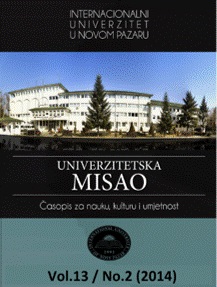POL NASTAVNIKA I OPĆI STAV O UVOĐENJU INOVACIJA U NASTAVU
TEACHER’S GENDER AND GENERAL POSITION ON THE INTRODUCTION OF INNOVATIONS IN THE EDUCATION PROCESS
Author(s): Muradif HajderSubject(s): Gender Studies, School education, Methodology and research technology, Sociology of Education
Published by: Интернационални Универзитет у Новом Пазару
Keywords: instruction; paper; form; teacher’s gender; innovations in education process;
Summary/Abstract: The aim of this empirical - transversal study was to determine the basic relations and relationship between teachers of different sexes (independent variable) and their general attitudes towards introducing innovations in teaching (dependent variable). The research has confirmed the first starting hypothesis and it has been found that teachers in primary and secondary schools have significant differences in the outspread of general attitudes towards introducing innovations in teaching, and the result of these differences are psychological characteristics of the personality of teachers and gender characteristics. The research has not confirmed the second starting hypothesis in which we assume that there are no significant differences in the general attitudes on the possible introduction of innovations in teaching considering the gender of teachers. The results showed that considering the gender, there are significant differences in their general attitudes towards introducing innovations in teaching and accurate indicators of the nature of these differences we have determined with the discriminant analysis. With the discriminant analysis were discovered some items of first and second order differentiation which clearly separate or discriminate teachers by gender in the general attitude to the introduction of innovations in teaching, and this was confirmed by determining the position of the value and the sign of the centroid. The sign of the value of centroid for male teachers is negative, while for the female teachers it is half positive. This may explain the tendency that between female teachers there is more of those with a strong positive attitude towards the introduction of innovation in education and much less those with extremely negative attitude towards the innovation of teaching work compared to male teachers.
Journal: Univerzitetska misao
- Issue Year: 2014
- Issue No: 13 (2)
- Page Range: 100-121
- Page Count: 22
- Language: Serbian

